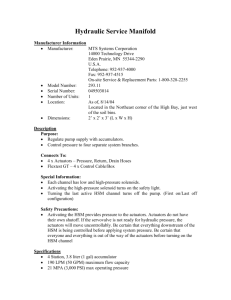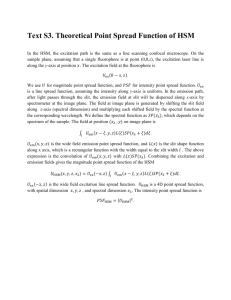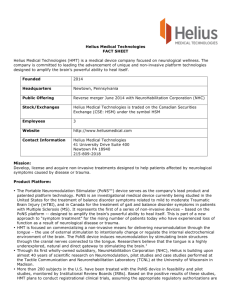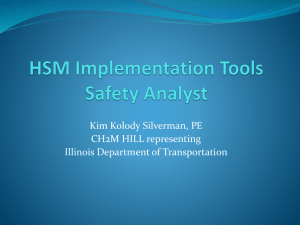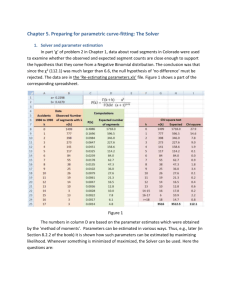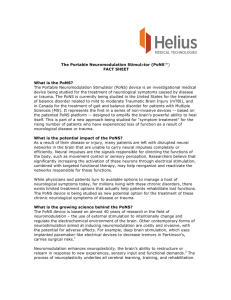nEUROhABILITATION cORPORATION
advertisement
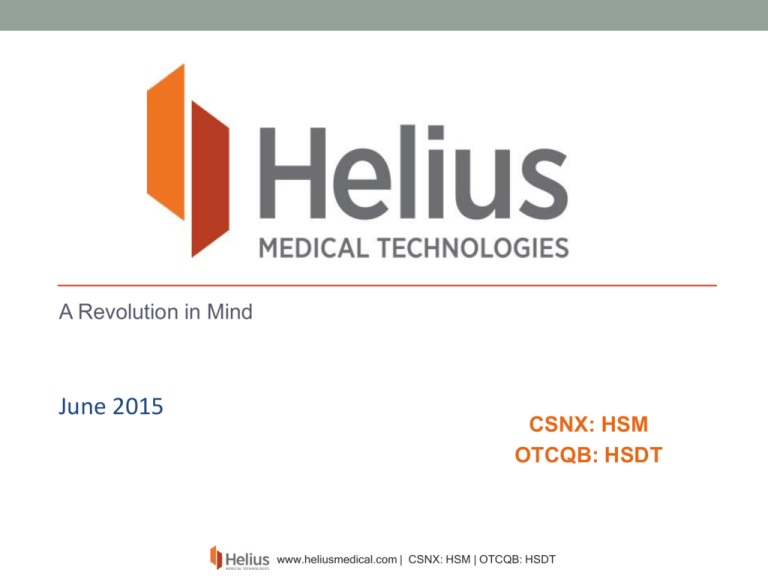
A Revolution in Mind June 2015 CSNX: HSM OTCQB: HSDT www.heliusmedical.com | CSNX: HSM | OTCQB: HSDT Disclaimer This presentation contains certain forward-looking statements that may involve a number of risks and uncertainties. Actual events or results could differ materially from Helius Medical Technologies expectations and projections. The Ontario Securities Commission has neither approved nor disapproved the information contained in this presentation. Except for statements of historical fact relating to the Company, certain information contained herein constitutes "forward-looking statements". Forward-looking statements are frequently characterized by words such as "plan", "expect", "project", "intend", "believe", "anticipate" and other similar words, or statements that certain events or conditions "may" or "will" occur. Forward-looking statements are based on the opinions and estimates of management at the date the statements are made, and are subject to a variety of risks and uncertainties and other factors that could cause actual events or results to differ materially from those projected in the forward-looking statements. These factors include the inherent risks involved in the development of medical devices and FDA or other international regulatory agencies, product obsolescence, the uncertainties involved in patent defense and complexities and timelines associated with medical device product approvals in multiple jurisdictions. The possibility of project cost overruns or unanticipated costs and expenses, uncertainties relating to the availability and costs of financing needed in the future and other factors. Circumstances or management's estimates or opinions could change. The reader is cautioned not to place undue reliance on forward-looking statements. www.heliusmedical.com | CSNX: HSM | OTCQB: HSDT 2 Overview Helius Medical Technologies Medical device company focused on neurological wellness and the development of unique, non-invasive, technologies to enable the brain to heal itself Portable Neuromodulation Stimulator or PoNS™ Device Electrode-covered oral device delivering specially-patterned nerve impulses to a patient's brain through appliance placed on the tongue PoNS treats neurological symptoms caused by disease or trauma Clinical experience with over 200 patients U.S. Armed Forces Collaboration Collaborative Research and Development Agreement (CRADA) Army our development partner and first customer Development and Clinical Trials Testing and studies, to date, provide encouraging indications Clearance by FDA expected Q3/Q4 2016 www.heliusmedical.com | CSNX: HSM | OTCQB: HSDT 3 Management Team Philippe Deschamps President, CEO • • • • 28 years in the Health Sciences industry MediMedia Health Marketing Services President and CEO - GSW Worldwide operations Director of Neuroscience Marketing at Bristol-Myers Squibb Jonathan Sackier Chief Medical Officer • 30 years in the Health Sciences industry • An innovator and pioneer of new technologies • Has helped build several companies including medical technology, research and product-design and medical contract sales organizations Experienced management team with expertise in healthcare and business development www.heliusmedical.com | CSNX: HSM | OTCQB: HSDT 4 Scientific Team: Inventors of PoNS Technology TM TACTILE COMMUNICATION AND NEUROREHABILITATION LABORATORY UNIVERSITY OF WISCONSIN–MADISON Department of Biomedical Engineering Founded in 1992 by a pioneer of Neuroplasticity, Dr. Paul Bach-Y-Rita • Research center using various areas of science to study the theory and application of applied neuroplasticity, the brain’s ability to reorganize in response to new information, needs, and pathways • Research objective to develop solutions for sensory and motor disorders TCNL Project Directors: Mitchell E. Tyler, Kurt Kaczmarek, Yuri P. Danilov • >20 years of individual experience in their respective fields of neuroscience, biomedical science, and engineering. • Co-discoverers of the retention effect and neurorehabilitation potential of tongue electrotactile stimulation • Recognized experts in electrotactile stimulation • Invented core tongue display technology Over 65 years combined experience in neuroscience, biomedical science, and engineering www.heliusmedical.com | CSNX: HSM | OTCQB: HSDT 5 Important Core Concept - Neuroplasticity • The ability of the brain to remain “plastic”, enabling new learning and the capacity to compensate for damage • The PoNS Device provides stimulation to the brain- stem and other brain structures via the cranial nerves • We believe this stimulation, when combined with a “task” (physical, cognitive or mental exercises) – enhances the brain’s self recovery mechanism – “re-engage” existing neural networks – reinforces new learning www.heliusmedical.com | CSNX: HSM | OTCQB: HSDT 6 PoNS 4.0 Device & MOA Theory TM Targeted Nerves • The trigeminal and facial nerves are stimulated by an electro array placed on the tongue • Stimulation translates into neural impulses, delivered directly into the brain stem, then dispersed throughout the brain • Stimulation seems to affect capacity organization and function of the structures www.heliusmedical.com | CSNX: HSM | OTCQB: HSDT 7 PoNS Development and Corporate Timeline TM 2014 (Q2) • 2013 (Q1) 2010 Entered into CRADA with US Army for R&D of PoNS in TBI • Helius acquired NHC and concurrently closed $7.6M Private Placement Initiated PoNS 4.0 Development Process PoNS 2.2 Experimental Device Released 1990 2014 (Q4) • Tactile Communications and Neurorehabilitation Laboratory (TCNL) Founded at University of Wisconsin-Madison ’90’s ’00’s • 2015 (Q2) Established Scientific Advisory Board led by Dr. Jonathan Sackier Issued 2 Patents for NINM for Rehabiliation of Brain Function • • • 2010–2012 2014 2013 PoNS 4.0 Released and Manufactured for Registrational Trial Issued 3rd Patent for NINM for Rehabilitation of Brain Function Completed recruitment of MS Pilot 2015 2014 (Q3) • • 2007 2013 (Q1) PoNS 1.0 Experimental Device Developed NHC founded as a 50/50 joint venture between ANR (inventors of the PoNS) and MPJ HealthCare (medical device commercialization experts). • Began TBI Pilot Studies for PoNS at UW-Madison Completed Commercial Design Specification and received prototype of PoNS 4.0 Began Trading on CSE under HSM Symbol 2015 (Q1) • • • • www.heliusmedical.com | CSNX: HSM | OTCQB: HSDT Modified CRADA to Speed Development of PoNS 4.0 Enrolled first subjects in MS Feasibility Study Listed on OTCQB under HSDT symbol Closed of CAD $2.2M Private Placement 8 PoNS retrospective analysis by Optum Health TM • 6/3/2015 - Optum conducted a third-party retrospective analysis to test statistical significance of patient outcomes from the use of PoNSTM device plus physical therapy versus physical therapy alone (standard of care) – Compiled data from 4 studies in patients with resistant neurological conditions secondary to disease or trauma – In these studies, patient outcomes were evaluated using the following ‘patient outcome tests’: • Dynamic Gait Index (DGI), Sensory Organization Test (SOT), Multiple Sclerosis Impact Scale-29 (MSIS-29) and Activities-specific Balance Confidence Scale (ABCScore). – Data across studies were aggregated by ‘patient outcome test’ and tested for statistical significance CONCLUSION: The use of the PoNSTM device in conjunction with physical therapy produced a statistically significant better outcome in patients with resistant neurological conditions secondary to disease or trauma www.heliusmedical.com | CSNX: HSM | OTCQB: HSDT 9 Data Analysis - Comprehensive The Dynamic Gait Index (DGI) is a clinical tool to assess gait, balance and fall risk. It evaluates not only usual steady-state walking, but also walking during more challenging tasks. It consists of 8 functional walking tests that are performed by the subject and marked out of three, according to the lowest category which applies. 24 is the highest individual score possible and scores of 19 or less have been related to increase incidence of falls. The Multiple Sclerosis Impact Scale (MSIS-29) is a 29-item self-report rating scale for measuring the physical and psychological impact of multiple sclerosis (MS). The sensory organization Test is a composite score is calculated and normalized for age and gender. Changes in Composite score of 5 points or greater are considered clinically significant. www.heliusmedical.com | CSNX: HSM | OTCQB: HSDT Case Studies – Multiple Sclerosis Psycho-Social A Spectrum of Symptoms Multiple Sclerosis Impact Scale (MSIS-29) Confidence Concentration Impatience Anxiety Worry about MS Mental Fatigue Sleep Wellbeing Physical Bladder/Bowel Control Spontaneity Slowness Self Transport Limits on Work Using Hands Limits on Mobility Limits on Depending on Others Socializing Uncoordinated Spasms in Limbs Tremors Heavy Limbs Stiffness Clumsiness Moving Indoors Clinically Significant Not at All Balance Carry Things Grip Physical Tasks Severity of Symptoms www.heliusmedical.com | CSNX: HSM | OTCQB: HSDT Extreme 11 Case Studies – Traumatic Brain Injury (TBI) Pilot Study evaluating Balance using the Sensory Organization Test (SOT) after PoNSTM + Exercise Sensory Organization Test (SOT) is designed to assess quantitatively an individual`s ability to use visual, proprioceptive and vestibular cues to maintain postural stability in stance. There are 6 independent sensory conditions tested, each condition consisting of three twenty second trials. Before and After 5 days of CN-NINM Training 100 90 47 10 SOT Points 80 70 22 62 ▲ of 5.0 = Clinically Significant Change 60 50 40 30 Four female subjects, mean 48.3 y/o 20 Moderate, close-head nonpenetrating, concussive TBI 10 9-11 Glasgow Coma Scale 0 Subject A Subject B Before Subject C Subject D After www.heliusmedical.com | CSNX: HSM | OTCQB: HSDT 12 Traumatic Brain Injury (TBI) • • $76.5B Cost to US /$10B+Total Estimated Market Size No SUITABLE ALTERNATIVE FOR TREATMENT AVAILABLE Athletic / Civilian Military Common Types of TBI due to Military Activity Causes of Civilian TBI • Explosive blast injury • Motor Vehicle Accident • Overpressure • Sports Related Injury • Penetrating injury • Assaults • Blunt trauma • Diffuse axonal injury • 100,000+ cases of TBI reported in US • 30,000/year Active Duty Soldiers TBI • 300,000 Retired Soldiers TBI • 28% of patients at Walter-Reed result in treatment >$100,000,000 annually • ESTIMATED MARKET SIZE • 5.3M living with TBI related disability1 • 1.75M cases of TBI reported in U.S./year 30% result in chronic symptoms • 30% Chronic Disability • $5B+ Estimated Market Size (mild to moderate) 1) 2010 – 2012, United States Source: _______ www.heliusmedical.com | CSNX: HSM | OTCQB: HSDT 13 US Army Medical Research and Material Command • Cooperative Research and Development Agreement (CRADA) with the US Armed Forces signed January 2013 – US Army commits non-dilutive funding and resources for PoNS™ research – US Army provides regulatory expertise, access to special regulatory relationship with the FDA, facilities and personnel as needed • Recent Agreement Modification signed January 2015 – Transfers mTBI trial sponsorship to Helius – Expedites commencement of mTBI trial, now projected for Q2:15 – Expands PoNS™ research into tinnitus, PTSD and sleep disturbances www.heliusmedical.com | CSNX: HSM | OTCQB: HSDT 14 Regulatory Pathway • FDA deemed the PoNSTM device a ‘non-significant risk device’ – Does not pose a significant risk to human subjects – 90-day regulatory review upon submission for de-novo clearance • Seeking a de-novo clearance from the FDA in 2 indications – Balance disorder related to mild to moderate TBI • Reviewed and cleared the registrational trial protocol • Primary endpoint is improvement in balance – Gait and Balance disorders related to MS • Parallel path to EU CE Mark and Health Canada MDL approval www.heliusmedical.com | CSNX: HSM | OTCQB: HSDT 15 PoNS™ Clinical Trials in TBI Chronic balance deficit due to mild-to-moderate Traumatic Brain Injury (TBI) • Feasibility study underway at the TCNL at the University of Wisconsin-Madison with 44 patients • Pivotal Phase III trial to commence in Q2:15 at – Oregon Health and Science University (Portland, OR) – Orlando Regional Medical Center (Orlanda, FL) – McGill University’s Montreal Neurological Institute and Hospital (Montreal, QC) • 120 patient double-blind, active control study • Primary endpoint is improvement in chronic balance deficit at 5-weeks • Interim data results at 90 patients www.heliusmedical.com | CSNX: HSM | OTCQB: HSDT 16 PoNS ™ Clinical Milestones Pre-clinical Pilot Study Begin FDA Reg. Trial Complete FDA Reg. Trial Submit FDA Filing Obtain Clearance/ Approval PoNS™ 4.0 Device | Cranial Nerve Non-Invasive Neuromodulation + Exercise CLINICAL STAGE PROGRAMS Traumatic Brain Injury Multiple Sclerosis * *Results Q4:15 Q2:15 Q4:15 Q2:16 Q3:16 Q2:16 Q2:17 Q3:17 Q4:17 Interim data from Montreal Neuro pilot 4Q15 www.heliusmedical.com | CSNX: HSM | OTCQB: HSDT 17 PoNS™ Device Design Milestones Phase 1 Specification Lock Design Lock Mfg. Clinical Supplies Mfg. Production Quality Management System Q3:15 Q4:15 PoNS™ 4.0 Device | Design and Manufacturing Timeline Timeline Q2:14 Q3:14 Q4:14 Q2:15 www.heliusmedical.com | CSNX: HSM | OTCQB: HSDT 18 Intellectual Property Issued Patents: • September 2014 – US Patent No. 8,849,407 • Skin Stimulation + physical therapy = Therapeutic outcome • December 2014 - US Patent No. 8,909,345 • Oral Cavity Stimulation + Physical exercise = Therapeutic output • March 2015 – US Patent No. 9,020,612 • Oral Cavity Stimulation + Cognitive exercise = Therapeutic outcome Pending Patent Applications: • Skin stimulation + cognitive exercise = Therapeutic output • 26 Design and utility pending patent for the PoNS 4.0 commercial device Future Patent Applications: • Proskauer Rose LLP aiding in expansion of IP development www.heliusmedical.com | CSNX: HSM | OTCQB: HSDT 19 Healthcare Transaction Model Cycle continues until physician is satisfied patient has sufficiently recovered Patient Physician Accredited Physical Therapy Center Physical Therapy Phone Center • Self Identified based on DTC Promotion • Healthcare Provider Identified • Patient purchases PoNS device though cash or private insurance reimbursement from the Accredited Physical therapy center/Therapist • Prescribes PoNS device • Prescribes Certified Physical Therapy Center/Therapist accredited in PoNS training • Prescribes course of 14 weeks of therapy • Orders PoNS device from Helius and direct shipped from OEM to the patient at first visit • Performs training for patient based on diagnosis and needs • Obtains reimbursement for services from private and public insurance • Discharges patient to home therapy • Monitors the patient daily for the first two weeks of at home therapy through phone or video interphase • Monitors the patient weekly (3-14) basis to ensure compliance and adherence to treatment protocol • Directs the patient back to the physician for assessment when 14 weeks of therapy are over www.heliusmedical.com | CSNX: HSM | OTCQB: HSDT Market Opportunity # of existing Patients New Patients/ year Multiple Sclerosis 1,000,000 10,000 TBI 5,300,000 1,750 million, 550,000 with Chronic disability 750,000 60,000 Stroke 7,000,000 795,000 Alzheimer’s Disease 5,400,000 1,200,000 Depression 21,000,000 11,000,000 PTSD 15,400,000 8,225,000 ADHD 5,752,000 2,600,000 100,000,000 5,000,000 Parkinson’s Chronic Pain • PoNS device + physical or other therapy potentially treats the symptoms of multiple brain disorders/trauma • Each Indication requires clinical trial (16 months and $3M of funding) www.heliusmedical.com | CSNX: HSM | OTCQB: HSDT 21 PoNS™ Initial Therapeutic Focus Areas Discovery / Preclinical Pilot Study FDA Registration Clinical Trial PoNS™ 4.0 Device | Cranial Nerve Non-Invasive Neuromodulation + Exercise CLINICAL STAGE PROGRAMS Traumatic Brain Injury Q2:15 Multiple Sclerosis Q2:16 Preliminary Data / Direct Evidence PRELIMINARY EVALUATION STAGE PROGRAMS Stroke Tinnitus (Ringing of Ears) Chronic Pain Post-traumatic Stress Disorder (PTSD) Sleep Disorders www.heliusmedical.com | CSNX: HSM | OTCQB: HSDT 22 Financial Information CSNX: HSM | OTCQB: HSDT Market Cap $138M Current Shares Outstanding: 64M Shares Fully Diluted Shares: 78M Shares (incl. Options and Warrants) Cash: $1.5M Debt: - • Financings – $1.8M from private placement closed April 30, 2015 www.heliusmedical.com | CSNX: HSM | OTCQB: HSDT 23 Summary • Proprietary breakthrough non-invasive technology to relieve neurological symptoms through precise neuro-stimulation via the tongue • Immediate addressable market of over $5B upon FDA clearance; market penetration potential in additional neurological indications • High unmet need, limited existing treatment alternatives • DOD partnership helps defray development cost and is our first significant customer • Anticipated commercialization roll-out 2H 2016 www.heliusmedical.com | CSNX: HSM | OTCQB: HSDT 24 US Investor Contact Todd James, Senior Vice President, The Trout Group LLC 646-378-2926 tjames@troutgroup.com Helius Medical Technologies, Inc. 41 University Drive, Suite 400 Newtown, PA 18940 T: 215 809 2018 E: info@heliusmedical.com W: www.heliusmedical.com www.heliusmedical.com | CSNX: HSM | OTCQB: HSDT 25 APPENDIX www.heliusmedical.com | CSNX: HSM | OTCQB: HSDT 26 Capital Structure & Financial Information Ownership* Shares Shares outstanding 63,968,461 # Shares Management 33,000,000** * all approximations above Stock Options Stock Options 4,920,000 Warrants from financings 8,882,032 CAD $0.60 Exercise Price 3,770,000 77,770,493 CAD $2.52 Exercise Price 100,000 CAD $2.92 Exercise Price 550,000 CAD $2.96 Exercise Price 400,000 CAD $3.20 Exercise Price 100,000 Fully Diluted ** Included in Fully Diluted Share Count Financial Overview: • $7.2M investment ($3M from NIH, $4.1 private non-dilutive donations) • $6.9M from concurrent financing with new listing • $1.8M from private placement closed April 30, 2015 • $1.5M Total in treasury Total 4,920,000 Warrants • Non-Dilutive Commitment: US Army – $11M est. for development of registration trial and regulatory submission – $20.0M est. for development of further indications (Tinnitus, PTSD and Sleep Disturbance) – $9.0M non-dilutive investment by US Army to date CAD $1.00 Exercise Price 8,430,000 CAD $3.00 Exercise Price 452,032 Total www.heliusmedical.com | CSNX: HSM | OTCQB: HSDT 8,882,032 27 Scientific Advisory Board (SAB) Established Jonathan Sackier, M.D., Chairman Scientific Advisory Board Ron Alterman, M.D., M.B.A. Harvard professor Neurosurgeon at Beth Israel (BIDMC) Expertise in movement rehabilitation D. James Surmeier, M.D. Chair of the Department of Physiology and Director of Parkinson’s Disease Research Center at Northwestern University Carl Hauser, M.D. Director of Trauma at BIDMC visiting professor of Surgery at Harvard Medical School Reggie Edgerton, M.D., Ph.D Professor in the Departments of Neurobiology, Integrative Biology and Physiology and Neurosurgery at UCLA Member of the Brain Research Institute Scott Parazynski, M.D. Former NASA astronaut Inventor/leader in the medical device/research fields Rick Celebrini, Ph.D Physiotherapist, Founder of Fortius Institute, Retired Canadian professional soccer player Canadian Medical team member at 3 Olympic games Head of Sports Medicine and Science for the Vancouver Whitecaps FC Catherine Cho, M.D. MSCR Assistant Professor in the Department of Neurology at The Icahn School of Medicine at Mount Sinai Jennifer Sweet, M.D. Department of Neurological Surgery University Hospitals Case Medical Center Gale Pollock, R.N., Former Commander of the US Army Medical Command Acting Surgeon General of the Army Fellow at the American College of Healthcare Executives, American Academy of Nursing and National Board of Corporate Directors. www.heliusmedical.com | CSNX: HSM | OTCQB: HSDT 28 Competitive Landscape Helius NeuroSigma Cyberonics and Others Cefaly None None $243M Just approved FDA Non Invasive Non Invasive and Minimally Invasive Invasive: Implantable Forehead Cutaneous stim. Approved Indications None None Drug Resistant Epilepsy Migraine Headache Units Sold None None 65,000 -- TBI, MS, Parkinson and Stroke Drug resistant Epilepsy, Post Traumatic Stress Disorder, Obesity, Cachexia Trigeminal and Facial Trigeminal Vagus Trigeminal Product Name PoNS Monarch VNS Cefaly Product Classification TBD TBD Class III Class II FDA Cleared No No Yes Yes Product Classification Class II TBD Class III Class II Annual Sales Type of Device Anticipated Indications Targeted Nerve www.heliusmedical.com | CSNX: HSM | OTCQB: HSDT 29 Cyberonics Case Study Focus on neuromodulation: developed and markets VNS Therapy System, a vagus nerve stimulation device implantation for refractory epilepsy and treatment resistant depression Ticker: CYBX Key Indication • Mkt Cap: $1.3bn VNS Device: Vagus Nerve Stimulation MOA: Unknown • Unmet medical need for treatment refractory epilepsy patients, estimated 9mm people with epilepsy >400,000 U.S. patients indicated for VNS Therapy VNS Therapy System • • • Financial Results & Projections Indication: Epilepsy, Depression Market Conditions • FDA-Approved Marketed WW • • Over $250M in annual Revenues Estimated >10% y/y growth Surgically implanted medical device delivering electrical pulsed signals to vagus nerve MOA not fully understood, but positive clinical results Clear evidence towards seizure reduction in refractory epilepsy • • • Majority of IP expired in 2011, but no new competition entering in VNS epilepsy space Continued demand for patient therapies in neuromodulation >3,000 physicians using VNS Therapy >100,000 implants to date Cyberonics provides important precedent for Helius adoption and success 30 www.heliusmedical.com | CSNX: HSM | OTCQB: HSDT Operational Milestones • PoNSTM (4.0) with OEM contract medical device manufacture and design company Ximedica – Design work complete with first clinical scale capacity Q1:15 • Generate Army Deployment Plan Q3:16 – Ensure VA system PT infrastructure is created for maximum deployment efficiency • Create Physical Therapy Support Network – Develop partnership with national suppliers by June 2015 – Develop certification plan for PTCs by May 2015 – Develop home base compliance monitoring structure ready to deploy Q2: 16 • Obtain CPT reimbursement code for device reimbursement Q1:17 • Develop International Regulatory Submission Package Q1:15 – Drive submission to Health Canada on a parallel track to the US submission www.heliusmedical.com | CSNX: HSM | OTCQB: HSDT 31
